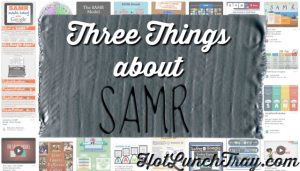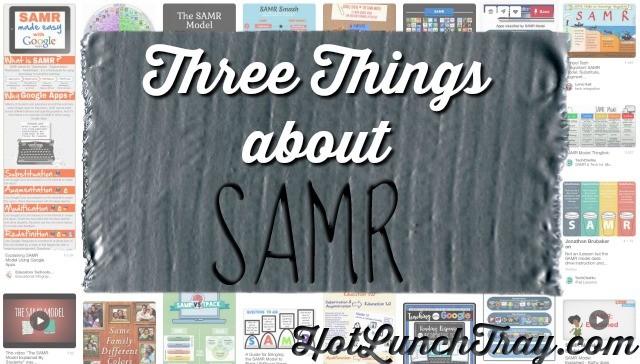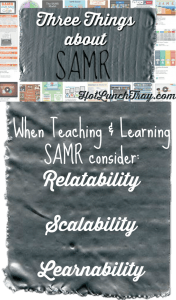Recently I listened to SAMR described in a new way which changed my opinion of its immediate usefulness with educators. When you view popular SAMR graphics you may consider your lesson planning process, how you cannot move all your lessons “up the ladder” at the same rate, and how much you just do not know/understand about this model of technology integration. But I need to share some perspectives which may shift your view of SAMR enough for you to revisit its usefulness.
Relatability
I heard an excellent talk (Jeff Utecht, GaETC16) where SAMR was presented in a very friendly way.
Jeff related personal technologies to our different personal uses for each technology. I noted how it reached Educators as consumers over professionally. It appeared to disarm many, to talk about personal uses of technology over educational applications. Educators were not confronted by something they were already “supposed” to know about, already be doing. But we had a space to laugh over our adoptions and new technologies washed over us a people.
Combining this newer way to explain SAMR and my continued interest in lesson design I am renewed. I am eager to work SAMR into my interactions with teachers, a new commonality with them as technology continues to evolve for everyone.
Scalability
Another way to shift the perception of SAMR is “one lesson at a time,” not all lessons all the time. When teachers select a starting place for their work, versus an every time perception the overwhelmed feeling does not interfere with their production. Helping to organize teacher groups into strategic creators of varying levels of SAMR levels could contribute to great appreciation for/understanding of the model itself.
I also mentioned this idea in the post: Different and not Better.
Teachers should start by selecting lessons which obviously lend themselves to technology enhancement or transformation. This is where Instructional Technology Specialists can contribute. But do not push for transformation each time. Instead look for the automatic hits and then compare those which were ‘enhanced’ to those ‘transformed’ searching for upgrade opportunities.
Do not imagine that this is a sequential progression either. Just because a teacher develops transformational lessons before Thanksgiving does not mean the rest of the year has to be transformational. Each lesson should be examined on its own. Lessons are constantly revised. The cycle is already there to slip in the appropriate integration of technology. Even when the appropriate amount of technology is none.
A great idea to fold into this discussion is the content revision cycle. In my post, Move Your Content: Version 1 to Version 2, I acknowledge the immense investment of teachers in the first version of any work product. Also the first version of something may not only take longer to produce, but may need to be experienced more than once before the need for revision become automatic. Share with teachers permission to bot be perfect the first time and to expect to revisit the content and improve upon it in the future.
Learnability
You likely know the New Media Consortium for the annual Horizon report they share on both K12 and Higher Education. But did you know that New Media Consortium also offers courses via their NMC Academy? NMC offers a self-paced SAMR course for those looking to learn more. NMH also provides a badge for display on LinkedIn. ![]()
This is a self-paced set of content which would be an excellent base for any educator. It would also be a nice boost for anyone who needs to round out their professional learning with a technology update.

The wide variety of visual representations of this model show the differing levels of understanding. These graphics range from uninformative to sometimes even misleading.
A graphic for SAMR is only as good if it helps clarify an understanding of SAMR.
With that in mind, beware of SAMR graphics which ….
Imply you should offer equal parts of redefinition to substitution – not true.
Beware of graphics which make it look like you have to do Substitution before you can do Augmentation – not true. The pool analogy is valuable because it shows movement back and forth between levels neutrally. And by showing that movement per lesson, it makes the goal lesson more attainable.
Beware of Starbucks graphics – they just give you coffee envy. Otherwise, they are a pretty good analogy for SAMR.
Watch out for graphics with lists of apps for each level of SAMR – this cannot be an exhaustive list and don’t t you think some apps could be in more than one category?
Beware of SAMR vs. TPACK – there is no contest, they are two different models.
Please take another look at the SAMR model with some of these fresh perspectives.







2017-01-13 at 4:15 pm
I always hate it when I work with a teacher and they feel (based on the graphics they’ve seen) that the SAMR Model is a ladder to be climbed with every lesson. NO!!! Just like in coloring, you have to select the color that fits the situation best. Sometimes you are coloring in a sunset which has some reds, oranges, & yellows other times you are coloring a sunrise which has some blues and purples. What works best in the situation you are planning for, if it is merely substitution, then thats what is instructionally appropriate.
2017-01-13 at 4:18 pm
What an awesome analogy – thank for sharing it!